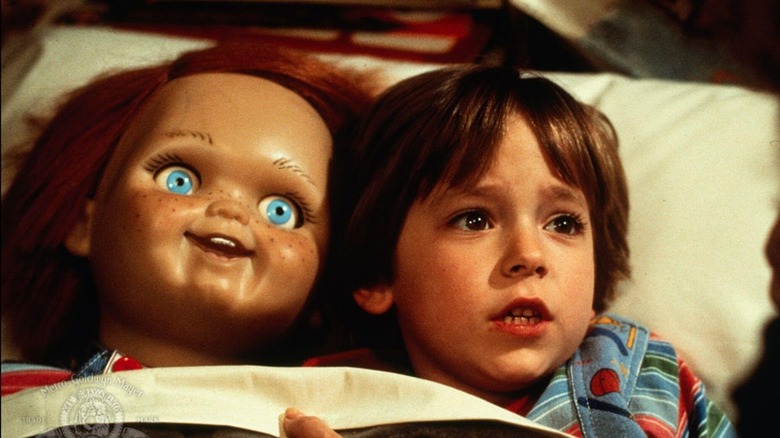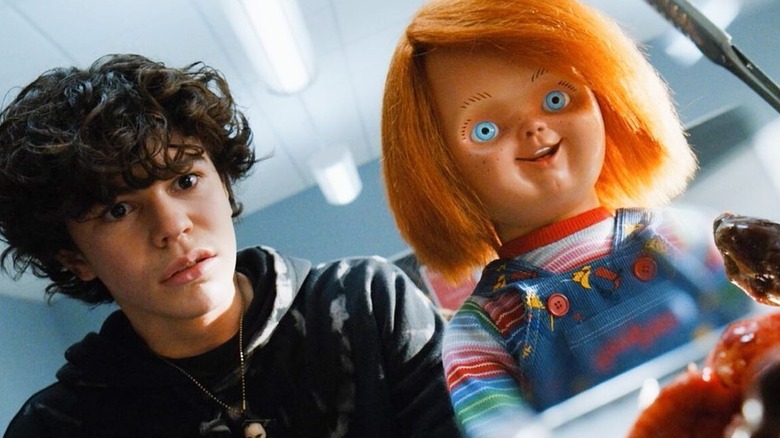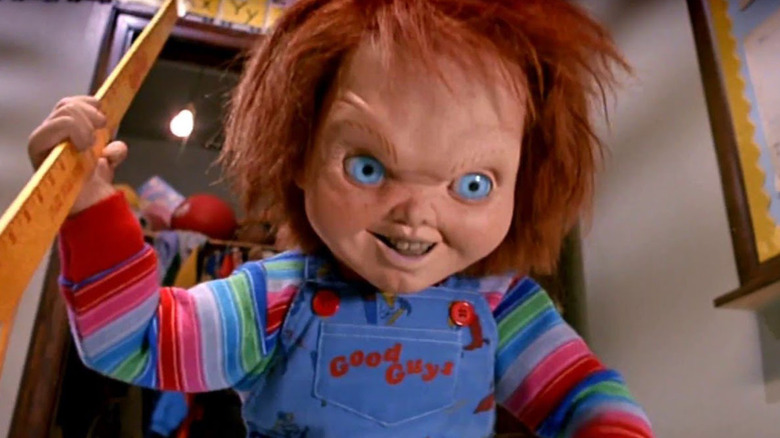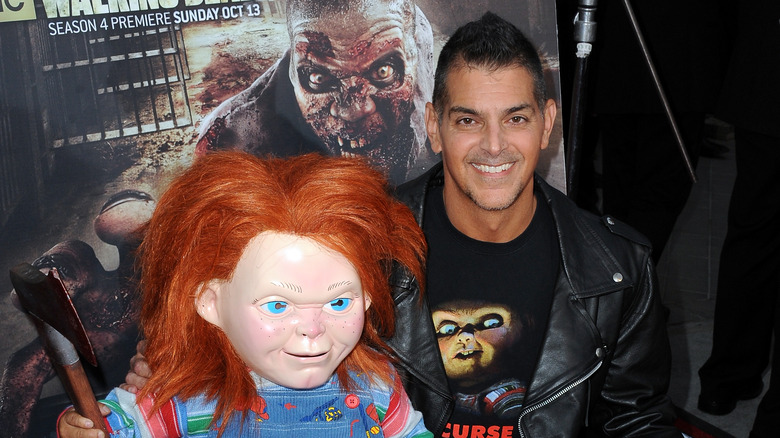
From "Annabelle" to "Chucky," the horror genre is filled with terrifying tales of evil dolls with homicidal intentions wreaking havoc on unsuspecting families. Unlike the alleged real-life events that inspired "Annabelle," the events depicted in the 1988 slasher flick "Child's Play" are regarded as a work of fiction; however, the tale of Robert the Doll, a real-life case of paranormal activity involving a haunted doll, has some pretty striking similarities to that of Chucky in "Child's Play."
The commonalities between Robert and Chucky are so great that some fans have come to suspect that Don Mancini, the creator of Chucky and screenwriter for all of the movies in the "Child's Play" franchise, must have inspired by Robert when creating his own possessed doll. Here's what we know.
The True Story Of Robert The Doll

As a folklore and horror obsessed Floridian, I am quite familiar with the story of Robert the Doll. As the legend goes, sometime in the early 1900s, a doll was given to a young boy named Robert "Gene" Otto in Key West, Florida. Gene was instantly enamored with the doll, giving it his old sailor outfit and even his very own first name: Robert. Soon after Robert entered the Otto household, reports of strange occurrences involving the doll began to occur. Residents and visitors of the home in which Robert resided said that they witnessed the doll move on its own, change facial expressions as though he was listening to nearby conversations, and emit a sinister laugh. Even Gene's own parents stated that they would often hear the young boy talking to Robert alone in his room, and that another voice would reply. Additionally, Gene would often blame mishaps, including rearranged and destroyed furniture, strange noises, and mysteriously mutilated toys, on Robert. Despite the doll's seemingly malicious nature, Gene was obsessed with Robert. He would carry him everywhere and referred often to him as if he were a living entity instead of a children's toy.
Eventually, Gene grew up and went to college in Chicago to study the arts, leaving Robert behind. However, after the passing of his parents, Gene moved back into his childhood home, which would come to be known in Florida as "The Artist House," and was pleased to find Robert there. He even gave Robert his own room, much to the dismay of his wife, who found the doll creepy and unsettling. Like Gene's parents and everyone else who encountered Robert years ago, Gene's wife also claimed that Robert seemed to possess a mind of his own, moving about the house, filling the halls with wicked laughter, and causing disturbances. She wanted Robert gone, but Gene was not eager to completely part with his childhood companion, so he conceded to lock Robert away in the attic. Interestingly, Robert routinely "escaped" from the attic, and passersby would state that Robert often sat in the window of the bedroom Gene had originally set aside for him, mocking them as they passed. No matter how many times Gene would make sure to return Robert to the attic, he would appear in various places throughout the house. Reports of Robert's mischief persisted.
After Gene died in 1974, Robert gained a new owner when The Artist House was purchased by a woman named Myrtle Reuter. Myrtle would live with Robert for 20 years before donating him to a museum, claiming that he would change facial expressions, move and walk around the house on his own, laugh evilly, and engage in other antics typical of a supernaturally possessed doll. Myrtle's visitors also routinely witnessed and spoke about various instances of Robert's haunted hijinks.
Eventually, Myrtle donated Robert to Fort East Martello Museum in Key West, Florida, claiming that the doll was indeed haunted. Robert remains at the museum to this day, and visitors often report strange occurrences in the presence of the doll, in addition to post-visit misfortunes that many attribute to "disrespecting Robert." The severity of Robert's alleged wrath is so extreme that the museum regularly receives apology letters addressed to Robert. Though the exact origins of Robert's paranormal behavior are unclear, legend has it that Robert was cursed by a mistreated servant of Gene's family, who used voodoo to exact her revenge by bringing life to the doll.
Robert Vs Chucky: Eerie Similarities

So that's the true story of the infamous Robert the Doll. If you're familiar with the fictional origin story of Chucky the killer doll in the "Child's Play" movies and "Chucky" TV series, you'll notice some obvious similarities between Chucky and Robert's respective stories. Like Robert, Chucky was a gift to a little boy who, at first, sees Chucky as his best friend and primary companion. In the first "Child's Play" movie, young Andy is obsessed with the "Good Guy" dolls, and is happy to receive one as a gift from his mother. Neither Andy nor his mother is aware that their particular Good Guy doll has been possessed by serial killer Charles Lee Ray, who inhabits the doll's body as the result of a voodoo spell in which Charles, also known as Chucky, transferred his soul into it. This is not unlike the supposed voodoo magic that led to the creation of Robert -- you know, minus the serial killer part.
Chucky's tale also parallels that of Robert's in that he is a living doll who causes chaos wherever he goes. Both dolls possess a mischievous nature, with Chucky taking his antics to murderous extremes, while Robert's evil escapades result in actual people begging his forgiveness after their lives suddenly take a turn for the worse upon meeting him. While there are no verifiable accounts of Robert going so far as to actually commit murder, many horror fans assume the "Child's Play" franchise was inspired by the true story of Robert the Doll. Even so, is there any actual evidence to suggest that Don Mancini was inspired by Robert when creating Chucky?
The Creator Of Chucky Weighs In

Despite the uncanny parallels between the legend of Robert of the Doll and "Child's Play," there is no verifiable evidence that lends credence to the rumor that "Child's Play" was inspired by the creepy reality of Robert's curious existence. In fact, Don Mancini has always been open about what inspired him to create everyone's favorite killer doll, stating that the source of inspiration was something that can be far more sinister than Robert and his dark origins: the advertising industry.
In a 2019 interview with Mental Floss, Mancini disclosed that he originally "wanted to write a dark satire about how marketing affected children," and that the popularity of the Cabbage Patch Kids at the time played a role. In that same interview, he mentions that the "killer doll" trope was not original in and of itself, but that he wanted to take it a step further than it had been at the time:
"Being a horror fan all of my life, I had seen Trilogy of Terror, I had seen the Talky Tina episode of The Twilight Zone, and I knew the killer doll trope. But what I realized was that it had never been done as a feature-length film in the age of animatronics." He goes on to say in that the original "Child's Play" script, the doll wasn't possessed at all. Instead, he was "a manifestation of a little boy's unconscious rage, his id."
Mancini's original script was reworked until we were eventually blessed with Chucky, the pint-sized homicidal maniac we know and love today. While having a "based on a true story" label can easily up the fear factor of any horror film, a scary movie doesn't have to be based on real life events to be good. Sometimes spooky similarities are little more than creepy coincidences.
Read this next: The 20 Best '60s Horror Movies Ranked
The post Was Child's Play Inspired by This Creepy True Story? appeared first on /Film.
0 Comments